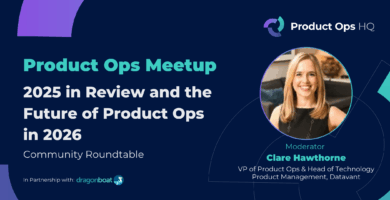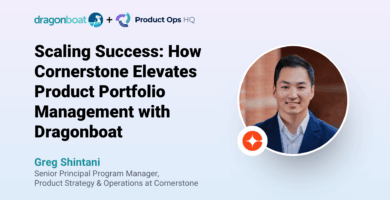Events • On Demand | Watch Time: 1 hr 2 mins
Unstuck: How Great CPO’s Move the Business Forward
ACCELERATE 2023: Virtual Summit for Product Leaders by Dragonboat
At the CPO roundtable during ACCELERATE 2023, several thought leaders shared their insights:
⭐ Carmen Palmer (CPO, Women in Product) advised to “slow down to speed up.” She emphasized the importance of investing in planning and communication, and how prioritization should account for both customer outcomes and business outcomes.
⭐ Scott Williamson (Product Advisor and Former CPO, GitLab) highlighted how dependencies can hinder empowered teams. Effectively managing these dependencies is crucial to fostering empowered product teams.
⭐ Cory Gaines (CPO, Blackhawk Network) shed light on the daily struggles of a product manager. He stressed the importance of alignment with stakeholders on outcomes, as this paves the way for handling the constant influx of ideas and requests.
⭐ Ryan Polk (CPO, Stack Overflow) introduced the concept of the “You are not your product” team typology, which guides when to adjust portfolio levels, emphasizing the need to divest from some product areas while investing more in others.
Watch the session on-demand now to learn more on how great product leaders move the business forward.
Featured Speakers

Scott Williamson
Product Advisor and Former CPO of GitLab
Product advisor helping B2B SaaS companies scale their products through periods of high growth. Scott also has extensive experience leading product at companies including GitLab, Twilio, SendGrid, and others.

Cory Gaines
CPO of Blackhawk Network
Product executive with over 20 years of experience building and growing products form both scaling companies and at fortune 100 companies such as Visa, Citibank, Bank of America, and PayPal.

Ryan Polk
CPO of Stack Overflow
Seasoned transformation leader and investor who is passionate about B2B products. Before becoming the CPO of Stack Overflow, he headed product at Carbon Black, and led Product and Technology Excellence at Insight Partners.

Carmen Palmer
CPO of Women In Product
Seasoned product leader with a rich background in technology, media, and a passion for mentorship. Before becoming the CPO of Women In Product, Carmen led Product at MarketCast, and held product leadership roles at NBCUniversal and Yahoo.


